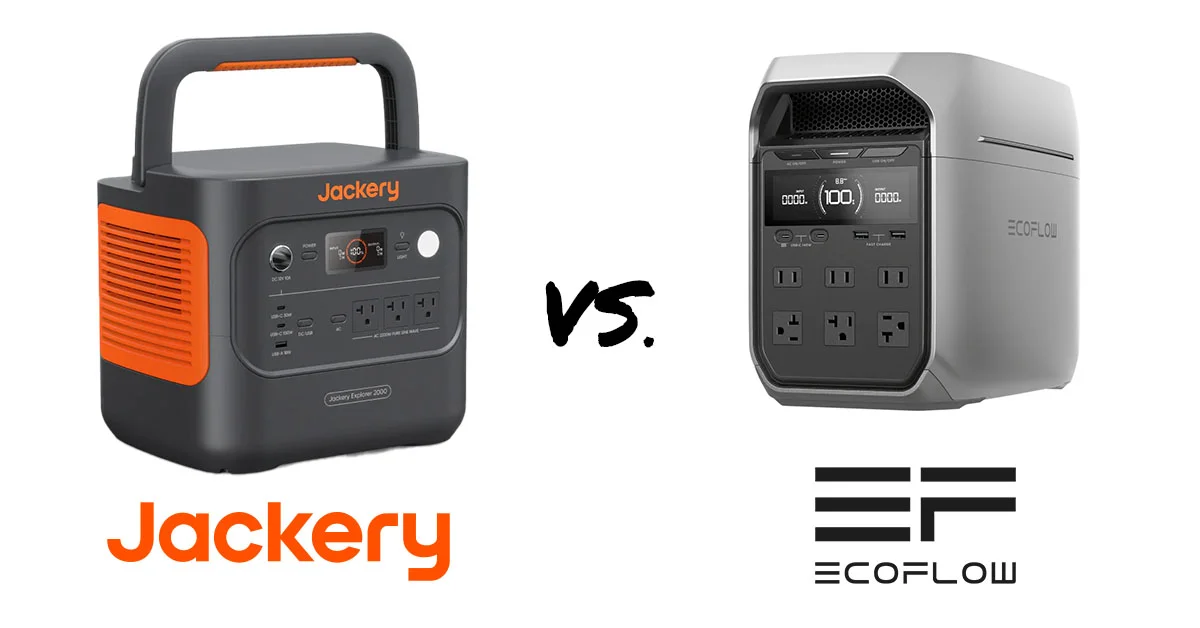It’s an exciting time in the portable power station market, with new options around every corner. In this detailed guide, we’ll examine how the new Jackery Explorer 2000 v2 compared to the EcoFlow Delta 3 Plus. Both are innovative options with attractive qualities, yet there are many ways they’re different.
Our expert team is here to translate the list of specs into a summary of the pros and cons. We’ll remove the wild advertising claims and industry jargon to show you the real-world implications of both power stations. How much can these devices power? Which has a bigger battery? And other vital questions will be answered.
Are you ready to see the difference between the Jackery 2000 v2 and EcoFlow Delta 3 Plus?
We carefully select the products and services we link to. If you buy through our links, we may earn a commission. There’s no extra cost to you and it helps us provide this information.
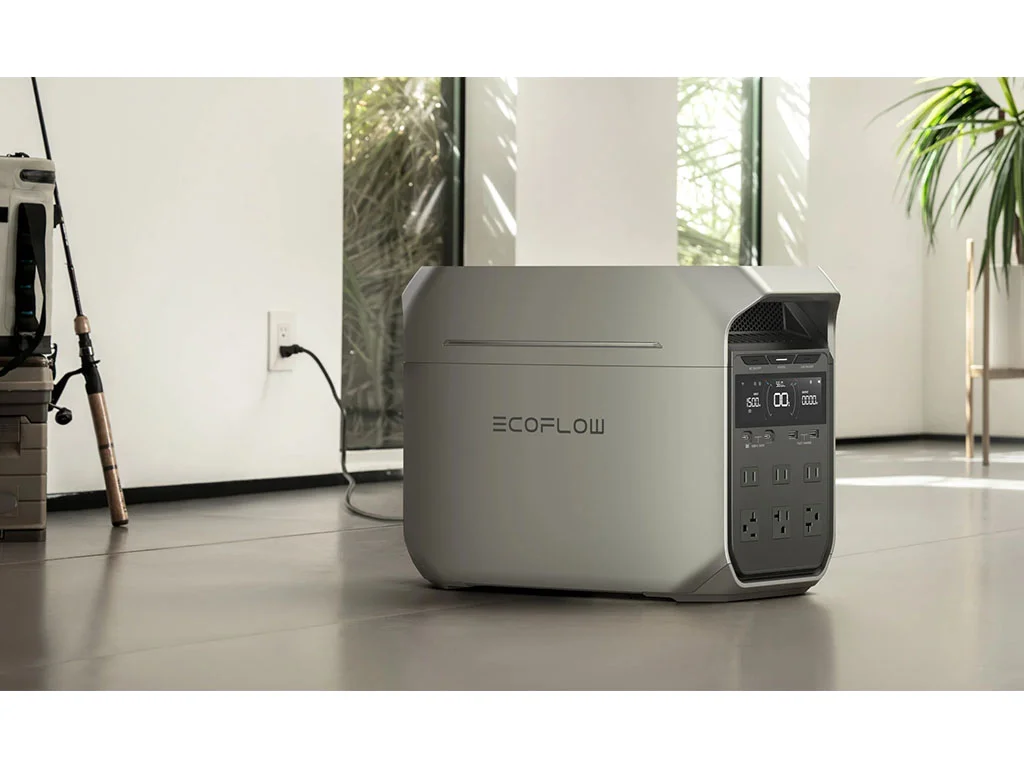
Short Summary
Jackery and EcoFlow have a lot of high-quality power stations. As two of the newest additions, the Jackery 2000 v2 and EcoFlow Delta 3 Plus are some of the most attractive. Although these offer a similar midrange energy level, they are incredibly different devices.
In some ways, the Jackery Explorer 2000 v2 is the better option. It has a:
- Larger internal battery
- More powerful AC inverter
- Incredibly compact design considering battery capacity
However, after looking at the details of the EcoFlow Delta 3 Plus, our attention is pulled the other direction due to its:
- Much lower price
- Ability to add extra battery packs
- Higher solar charging limits
- Superior outlets and UPS transfer time
After weighing these two power stations, the EcoFlow Delta 3 Plus offers a much better value while retaining or exceeding most of the capabilities of the Jackery Explorer 2000 v2. The largest downside is the smaller internal battery. For those that want a single compact unit, the Jackery Explorer 2000 v2 is the better choice.
| Product | EcoFlow DELTA 3 Plus | Jackery Explorer 2000 v2 |
|---|---|---|
| Battery | 1,024Wh | 2,042Wh |
| Battery (System Max) | 5,120Wh | 2,042Wh |
| AC Output | 1,800W | 2,200W |
| Solar Input | 1,000W | 400W |
| Warranty | 5 years | 3-5 years |
| Weight (lbs) | 27.6lbs | 39.5lbs |
| Weight (kg) | 12.5kg | 17.9kg |
| UPS / EPS | 10ms | 20ms |
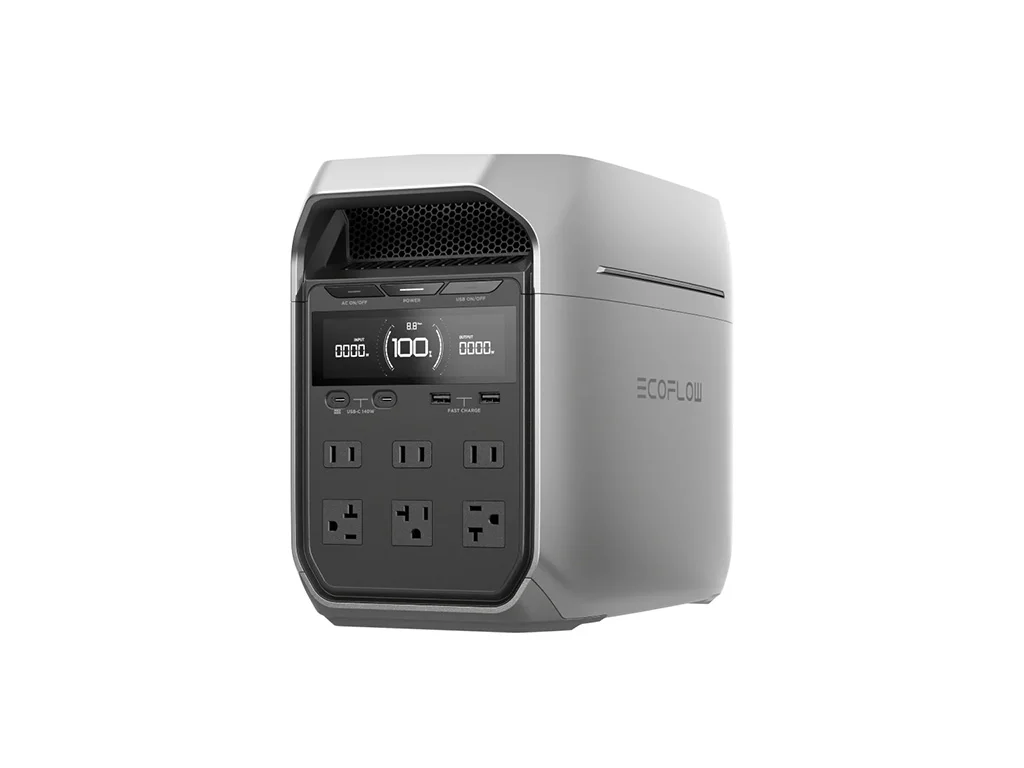
|
EcoFlow DELTA 3 Plus |
D3P on EcoFlow D3P on Amazon |

|
Jackery Explorer 2000 v2 |
2000v2 on Jackery 2000v2 on Amazon |
Get 5% off most EcoFlow orders with SOLARWAY5OFF discount code. See our EcoFlow Sales and Prices to make sure you get the best deal.
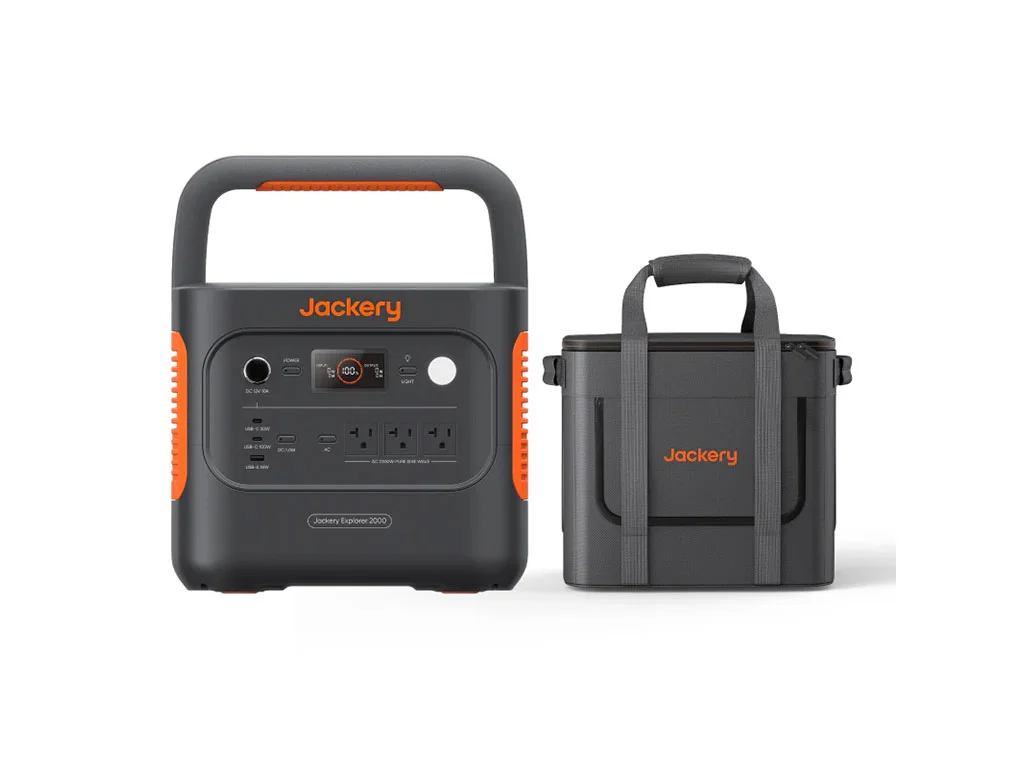
Detailed Comparison
Here’s how we’ll cover the Jackery Explorer 2000 v2 vs. EcoFlow Delta 3 Plus power station comparison:
- What Can These Power? Inverter & Outlets
- How Long Will They Last? Battery and Warranty
- Can They Recharge Quickly? Charging Speeds
- What Does Each Brand Offer? Unique Features
- Which Is a Better Size? Weight and Dimensions
- Final Verdict: Jackery 2000 v2 vs. EcoFlow Delta 3 Plus
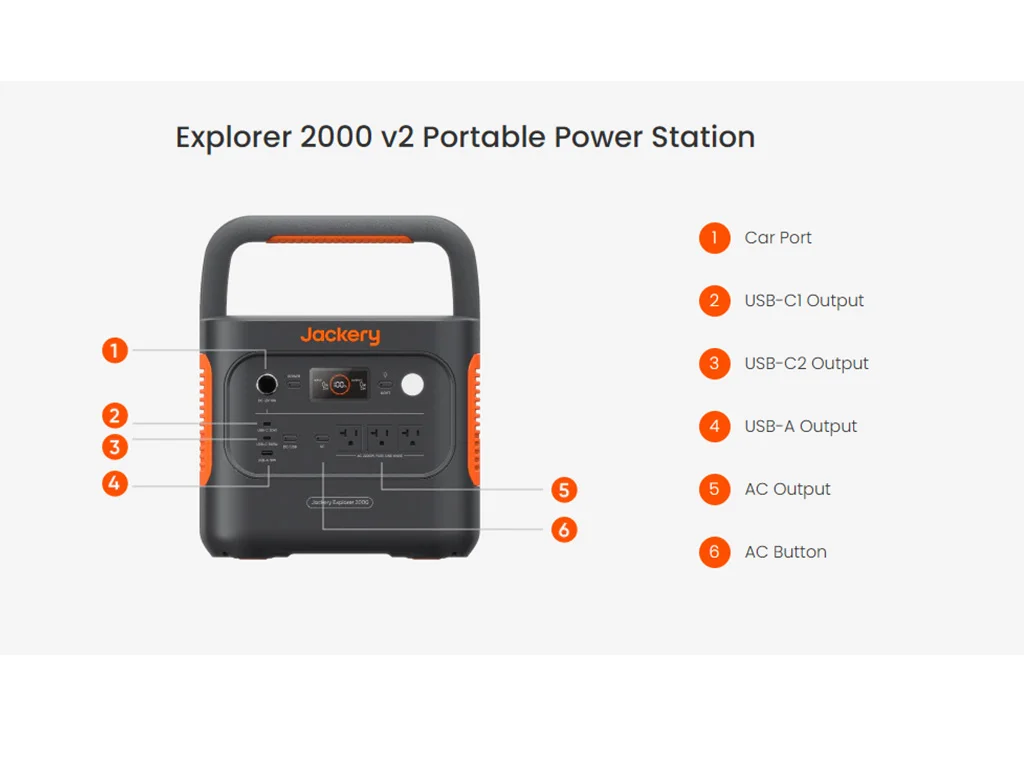
What Can These Power? Inverter & Outlets
There are a lot of aspects to consider before buying a power station, but the most critical is whether it can power the devices you want to run or not. This involves understanding the inverter’s output power as well as the number of connections.
Our favorite midrange power stations usually have AC inverters rated for around 2,000W (2kw), which both of these options have:
- Jackery 2000 v2: 2.2kW inverter, 3 outlets, <20ms UPS
- Delta 3 Plus: 1.8kW, 6 outlets, <10ms UPS
There’s no doubting the Jackery has a more powerful inverter. Yet it has half the number of outlets. Plus, the EcoFlow power station includes a special X-Boost function where it can run devices at 3,600W for extended periods (by lowering the voltage).

Here are some examples of items you can run on these power stations:
- 50W or less: Small fans, WiFi routers/modems, small device chargers
- 100W to 500W: Televisions, computers, and refrigerators
- 500W to 1,500W: Blenders, microwaves, hairdryers, and coffee makers
These have no problems running small devices and many different home appliances. Ones that generate a lot of heat or use electric warmers (coffee makers) are getting close to the 2kW limit. To run a 3kW air conditioner or other heavy-duty appliance, you’ll need to get a larger power station, like the EcoFlow Delta Pro 3 or Bluetti AC500.
The UPS time difference (<10ms vs. <20ms) might not seem like much. But if using this power station as a uninterruptible power supply (UPS) is a priority, the EcoFlow’s <10ms has a much better chance at avoiding data loss or damage cause by sudden shutoff. 10ms is a fairly standard UPS transfer time, which is the time it takes to notice a power outage from a wall outlet and switch to internal battery power. 20ms or less is still respectable, but some computers and other sensitive devices will reboot suddenly.
The DC outputs such as the USB ports and 12V car outlets are also crucial. It’s ideal to use the DC ports rather than relying on the AC outlets to maximize battery life. The AC inverter uses some power to run.
The EcoFlow Delta 3 Plus outdoes the Jackery Explorer 2000 v2 quite dramatically. It has an extra USB-A port, better USB-C ports, and two additional 5521 DC barrel plugs. Having two full-power (>100W) USB-C ports is extremely useful. You can fast charge phones and power laptops.
Jackery has minimized the ports and outlets in order to focus on an ultra-compact size. This is a tradeoff that may be useful for those that want to prioritize portability.
Output Verdict: Despite the Jackery Explorer 2000 v2 having a slightly more powerful inverter, the EcoFlow Delta 3 Plus has the advantage. It has more AC outlets backed by a capable inverter with unique X-Boost function. And the EcoFlow has 3 more DC outlets, including more powerful USB-A and USB-C options.
| Product | EcoFlow DELTA 3 Plus | Jackery Explorer 2000 v2 |
|---|---|---|
| AC Output | 1,800W | 2,200W |
| AC Output Peak | 3,600W | 4,400W |
| 120V Outlets | 6 | 3×18.3A |
| UPS / EPS | 10ms | 20ms |
| USB-A Ports | 2x36W | 1x18W |
| USB-C Ports | 2x140W | 1x100W; 1x30W |
| DC 5521 (Barrel Plug) | 2x38W 3A | – |
| Cigarette Lighter | 1x126W | 1x120W |
| Connectivity | WiFi / Bluetooth | WiFi / Bluetooth |

How Long Will They Last? Battery and Warranty
When it comes to the battery, the capacity is vital. But you also should be concerned about the type of battery it is. Some will last a few years before noticeable degradation; others can go for nearly a decade while still holding a charge.
Both of these use LiFePO4 lithium battery cells, the industry gold standard, and are backed by a 5-year warranty. Jackery advertises 4,000 cycles while keeping 70% battery capacity. EcoFlow brings a third-generation LiFePO4 battery pack, offering 4,000 cycles with at least 80% capacity. If well cared for, these can last about 8 to 10 years of daily use while still having most of the capacity intact. Extreme longevity.
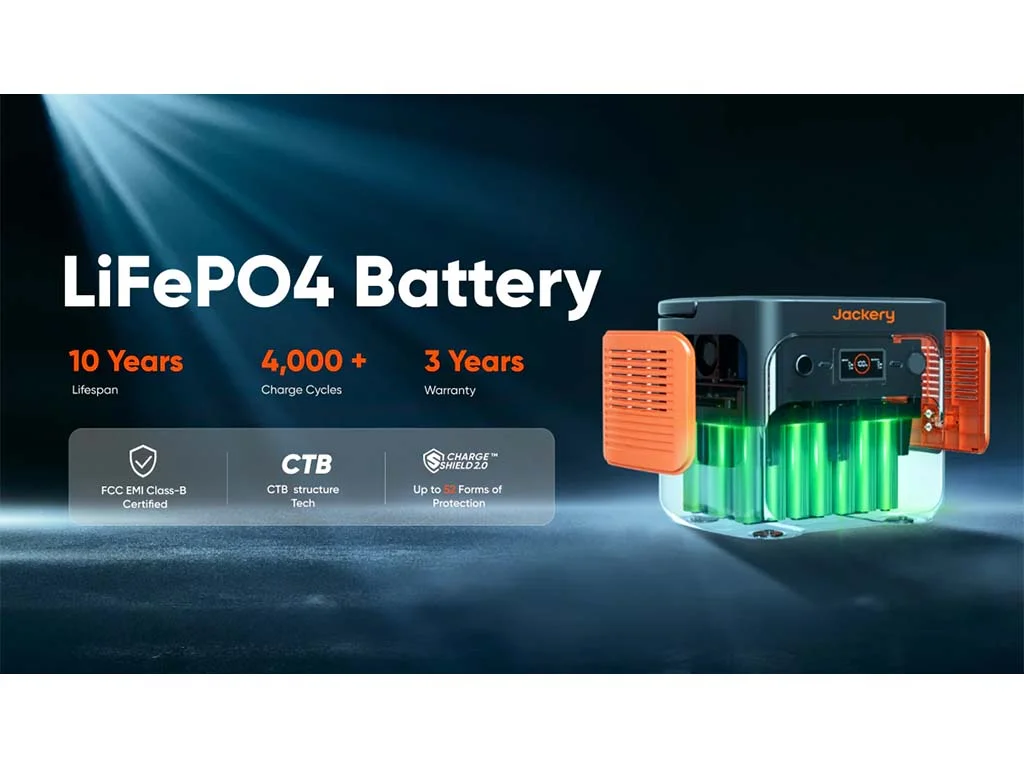
The capacity determines how long the power station will run any particular set of devices.
The Jackery 2000 v2 has 2kWh battery capacity, double the 1kWh internal battery capacity of the EcoFlow Delta 3 Plus. The Jackery will run the same set of devices for twice as long. This is one area where the Jackery is unequivocally superior to the EcoFlow.
Yet that’s not the whole story. This Jackery is not designed to use external battery packs. But the EcoFlow can use one extra battery pack. There are many compatible EcoFlow Extra Batteries to choose from, allowing you to add another 1kWh to 4kWh of additional capacity.
If you use the largest EcoFlow Delta Pro 3 Extra Battery, your Delta 3 Plus can have a total capacity of 5kWh. The only catch is that the extra battery units are expensive. You can match the 2kWh battery of Jackery 2000 v2 with the Delta 3 Plus and the Delta 2 Smart Battery. And you’ll still spend less money.

Here’s an idea of how long Jackery’s 2kWh battery can last (EcoFlow’s internal is half, but it can be up to 5kWh total):
- Charging:
- 10Wh phone battery ~160 times
- 30Wh tablet battery ~50 times
- 60Wh laptop battery ~25 times
- Powering:
- 20W small fan or WiFi router ~80 hours
- 50W CPAP machine or mini fridge ~32 hours
- 200W full size fridge or television ~8 hours
- 500W load of many devices ~3 hours
The Jackery has a lot of power for small and medium devices. As you get up to the full-size fridge and adding up the wattage across many devices, the hours get a little short. These two power stations can handle camping adventures with charging phones, powering lights, and running a portable fridge. They can also handle short-term home backup needs, preventing a fridge full of wasted food and keeping your critical devices going.
You can use a watt meter plug to see how much energy your devices use as well. This is ideal to verify your unique situation’s power needs.
If you want more hours, then the EcoFlow Delta 3 Plus is a better choice. You can add a 4kWh external battery to get 5kWh in total.
Battery Verdict: We prefer to modular nature of the EcoFlow Delta 3 Plus with 1kWh internal and 5kWh possible battery capacity. The Jackery Explorer 2000 v2 has a larger 2kWh internal battery but cannot use external battery packs. Both use high-quality LiFePO4 batteries with 5 years of warranty coverage.
| Product | EcoFlow DELTA 3 Plus | Jackery Explorer 2000 v2 |
|---|---|---|
| Battery | 1,024Wh | 2,042Wh |
| Battery (System Max) | 5,120Wh | 2,042Wh |
| Warranty | 5 years | 3-5 years |
| Battery Type | LiFePO4 / LFP | LiFePO4 / LFP |
| Battery Cycles | >4,000 | >3,000 |
| Buy Now | Buy D3P | Buy 2000 v2 |
| Buy on Amazon | Buy on Amazon | Buy on Amazon |
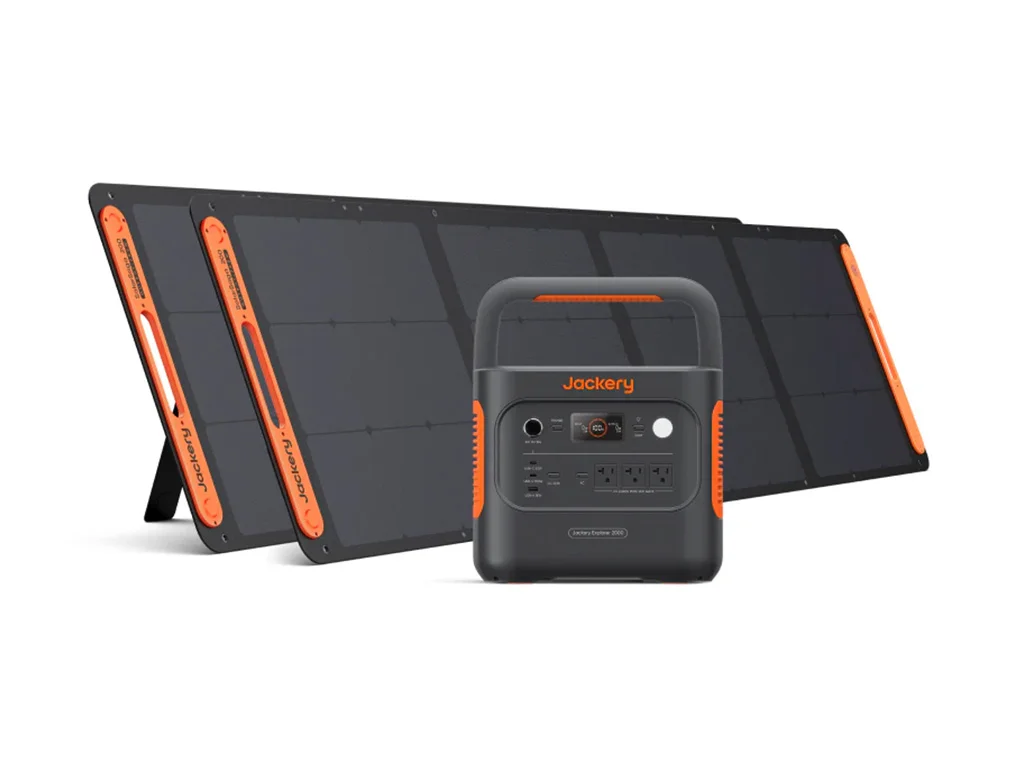
Can They Recharge Quickly? Charging Speeds
Charging speeds are not only about the power source or how many solar panels you connect. Each power station has limits to how quickly they can recharge the battery, determined in watts. The higher the watts, the faster the charging speed.
EcoFlow consistently prioritizes charging speeds and has done so again with the Delta 3 Plus. Jackery tends to take a more practical approach, allowing for fast charging from a wall outlet but more limited solar panels. Here’s a quick look at the difference:
- EcoFlow: Full 15A from a standard wall outlet (rated at 110V is 1,500W) and up to 1,000W from solar panels through two inputs
- Jackery: Full 15A from a standard wall outlet (rated at 120V is 1,800W) and up to 400W from solar panels through two inputs
This is a little backward from what you’d expect. The Jackery has a bigger battery. In theory, it should accept more solar power. But it’s less than half, taking over 6 hours to recharge even if you can maximize 400W the entire time. In reality, it’s likely to take longer than a day to recharge the Jackery’s 2kWh battery from solar alone.

Why does Jackery do this? It’s debatable whether they notice that the majority of customers don’t use more than 400W or if they are stuck in a more traditional mentality where solar power is limited to supplemental. For us solar experts and enthusiasts, we know that many of our customers do indeed maximize solar charging. It’s consistently relied on by many as their primary source of power.
EcoFlow does not have that problem. If you can generate 1,000W through solar panels, you can recharge in less than an hour and a half.
Car charging is usually limited to 120W since that’s the maximum output of the 12V cigarette lighter ports in most cars. The EcoFlow 800W Alternator Charger is a super-powered charging source that can fill the battery in just over an hour while you’re driving. Jackery doesn’t have a comparable alternative, but you can read our article on Universal Power Station Car Chargers to see other ideas.
Charging Verdict: EcoFlow dominates with solar charging speed despite its smaller battery. It can use up to 1,000W, more than double the Jackery’s 400W of solar. The EcoFlow 800W Alternator Charger is a nice upgrade for those that want fast charging while driving. Both power stations offer maximum charging speeds from a wall outlet, accepting the full 15A of power from a standard outlet.
| Product | EcoFlow DELTA 3 Plus | Jackery Explorer 2000 v2 |
|---|---|---|
| AC Input | 1,500W | 1,800W |
| AC Recharge Hours (Est.) | 0.8h | 1.4h |
| Solar Input | 1,000W | 400W |
| Solar Recharge Hours (Est.) | 1.2h | 6.1h |
| Solar Input 1 Watts | 500W | 200W |
| Solar Input 1 Volts Min | 11V | 11V |
| Solar Input 1 Volts Max | 60V | 60V |
| Solar Input 1 Amps | 15A | 12A |
| Solar Input 2 Watts | 500W | 200W |
| Solar Input 2 Volts Min | 11V | 11V |
| Solar Input 2 Volts Max | 60V | 60V |
| Solar Input 2 Amps | 15A | 12A |
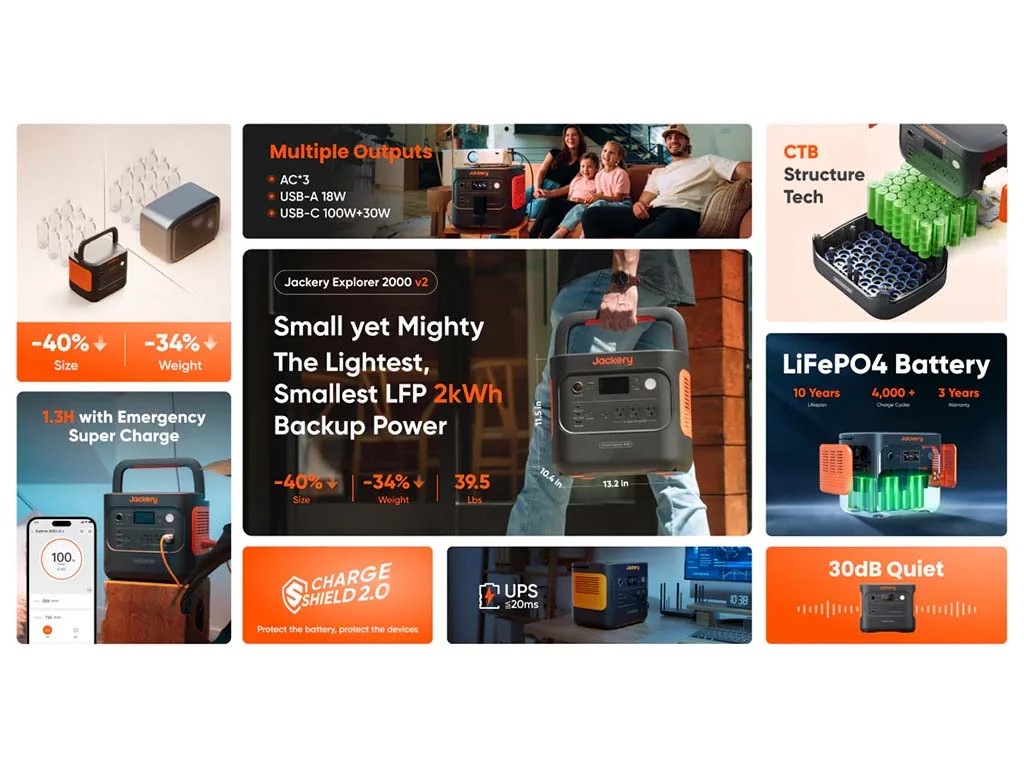
What Does Each Brand Offer? Unique Features
Many power station brands come up with unique marketing names for included features and capabilities. We use these as a sign of what the design focuses on.
One feature worth pointing out in both of these power stations is the quiet operation. The 2000 v2 and 3 Plus offer <30dB running noise, no louder than a whisper. Some power stations have fans that can disrupt your peace like a jet engine. Not these two.
Now let’s see some of the unique features from these brands. The Jackery Explorer 2000 v2 includes:
- CTB Technology: Compact honeycomb structure design maximizing durability and minimizing size
- ChargeShield 2.0: Efficient charging with intelligent protection
- Extreme Kit: Optional packs for hard winter conditions

The EcoFlow Delta 3 Plus has these features:
- X-Boost: Extra continuous power from the inverter
- X-Stream: Supercharged AC charging rates
- BMS Protection: Over 40 damage-avoiding functions built in
The X-Boost inverter rating is the one that sticks out to us as the most unique. EcoFlow drops the voltage of the AC inverter output to allow for increased wattage (volts x amps = watts). This is a good way to power devices over the usual continuous rating. Due to the lower voltage, it’s not compatible with all electronics.
Unique Features Verdict: The quiet noise operation, battery protection, and fast charging features across both brands are similar and noteworthy. EcoFlow brings a slight advantage with its X-Boost inverter function but Jackery’s compact CTB technology is also impressive.

Which Is a Better Size? Weight and Dimensions
This category is one that can vary wildly in this midrange power station segment. We’re also not dealing with an apples-to-apples comparison due to the Jackery’s much larger internal battery. Yet once again, the portability and design of these two options are commendable.
The Jackery Explorer 2000 v2 is almost 20lbs (9kg) less than options with the same battery size. Weighing less than 40lbs (18kg), it’s a remarkably compact option considering its capabilities. This is one reason for the more limited ports and outlets. Jackery kept the design as small and minimalistic as possible.
On the other hand, the EcoFlow Delta 3 Plus is nearly the weight of small compact power stations at just 27.6lbs (12.5kg). Yet it brings a powerful inverter and tons of physical connections. Even its 1kWh internal battery is typically hard to hide. You can’t beat the size to performance of the EcoFlow, although Jackery gives it a run for the money.
The downside to EcoFlow’s design comes when you use an extra battery. Not only is it extra weight, but it’s also likely to have a much larger footprint. It’s part of the price for the modular system. More flexibility but not as compact.
Size Verdict: These two midrange power stations are remarkable for their compact design, both beating similar options by a mile. Jackery’s overall structure is specifically geared for ultra-portable use. EcoFlow undercuts it due to its smaller internal battery, but if you use an external battery, those savings are lost.
| Product | EcoFlow DELTA 3 Plus | Jackery Explorer 2000 v2 |
|---|---|---|
| Weight (lbs) | 27.6lbs | 39.5lbs |
| Weight (kg) | 12.5kg | 17.9kg |
| Dimensions (in) | 8.0×15.7×11.2in | 13.2×10.4×11.5in |
| Dimensions (mm) | 202x398x284mm | 335x264x292mm |

Final Verdict: Jackery 2000 v2 vs. EcoFlow Delta 3 Plus
Even though it has a smaller internal battery and less-powerful inverter, the EcoFlow Delta 3 Plus is an incredible power station that wins out in this comparison against the Jackery Explorer 2000 v2. EcoFlow offers this innovative device at an amazingly low price. Plus, the Delta 3 Plus can:
- Use modular battery packs to reach 5.1kWh total
- Charge with up to 1,000W of solar panels
- Transfer to internal backup battery with 10ms
Everything on this list is double that of the Jackery unit. And each one can make a major difference in what the power station can power and how well it does the job. Considering the rock-bottom price of the EcoFlow Delta 3 Plus, the bar is set high. Even with an extra battery pack, it’s still lower than the Explorer 2000 v2’s MSRP.
Yet there are times when the Jackery Explorer 2000 v2 is worth reaching for instead.
The Explorer 2000 v2 has a larger 2kWh internal battery and an ultra-portable design you can’t find elsewhere. Its inverter is significantly more powerful with 2.2kW available for continuous use. You can’t expand the battery, the number of ports and outlets is slightly limited, and the solar input has a 400W maximum. If those are within your needs, it’s another top-tier power station that’s worth the extra cost. The price of this Jackery is extremely competitive against other power stations with 2kWh batteries.
Here’s a quick rundown of our analysis:
- Inverter & Outlets: Jackery has a more powerful 2.2kW inverter; EcoFlow has 1.8kW output but more ports and outlets.
- Battery and Warranty: Jackery has larger 2kWh internal battery; EcoFlow has 1kWh internal and up to 5kWh through modular expansion.
- Charging Speeds: Jackery can use full 15A AC power and only 400W solar; EcoFlow can use full 15A AC power and 1,000W solar.
- Unique Features: Jackery uses a unique honeycomb compact design; EcoFlow offers X-Boost push the inverter higher.
- Weight and Dimensions: Both are ultra-compact units, separated only by the major internal battery difference.
The aspect off this list is price. The EcoFlow is typically around 50% the cost of the Jackery. Check the EcoFlow Sales and Prices page to see the current prices from all top retailers (plus our 5% off SOLARWAY5OFF discount code) or use the below links to see current prices of both.
Final Verdict: With an unbeatable price and feature-packed design that’s ready for adventure and home backup, the EcoFlow Delta 3 Plus is our recommended pick against the Jackery Explorer 2000 v2. The Jackery is a great unit that’s better for those who need larger internal battery and an ultra-compact shape.

|
EcoFlow DELTA 3 Plus |
D3P on EcoFlow D3P on Amazon |

|
Jackery Explorer 2000 v2 |
2000v2 on Jackery 2000v2 on Amazon |
Get 5% off most EcoFlow orders with SOLARWAY5OFF discount code.
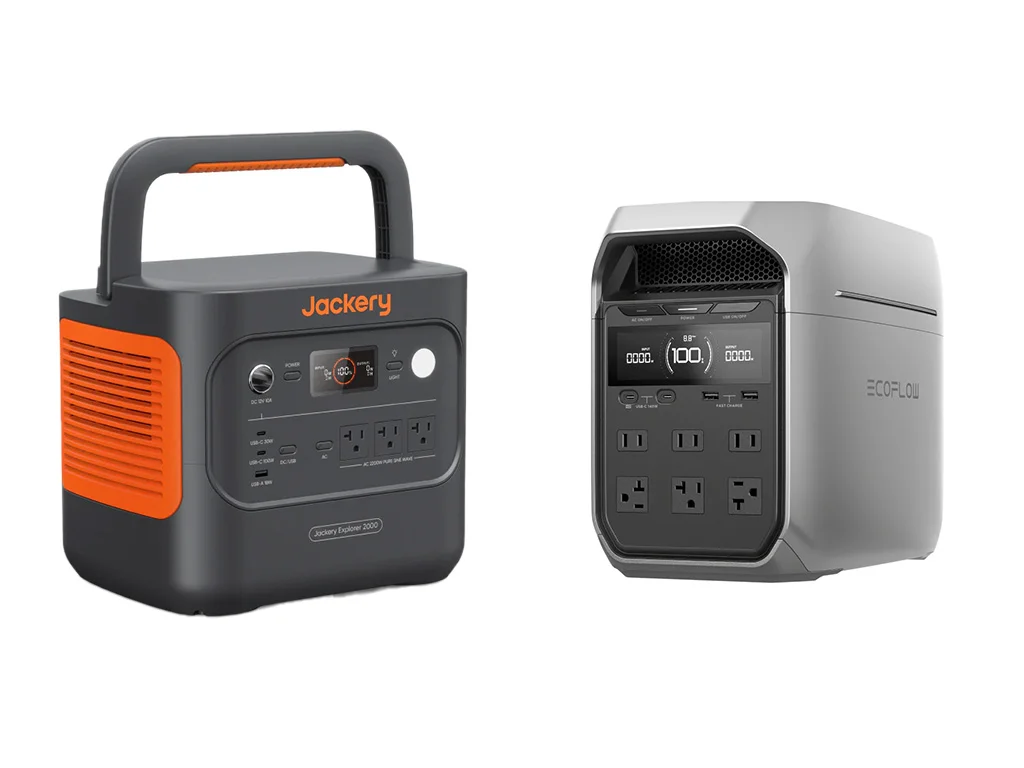
Full Comparison Charts
It’s always worth comparing the specs side-by-side for any power station. We’ll cover this particular comparison first, then provide a unique tool you don’t want to miss.
Jackery 2000 v2 vs. EcoFlow Delta 3 Plus
Here’s the full spec compaison table for the Jackery 2000 v2 vs. EcoFlow Delta 3 Plus, including links to the official user manuals:
| Product | EcoFlow DELTA 3 Plus | Jackery Explorer 2000 v2 |
|---|---|---|
| Battery | 1,024Wh | 2,042Wh |
| Battery (System Max) | 5,120Wh | 2,042Wh |
| AC Output | 1,800W | 2,200W |
| AC Output Peak | 3,600W | 4,400W |
| AC Input | 1,500W | 1,800W |
| AC Recharge Hours (Est.) | 0.8h | 1.4h |
| Solar Input | 1,000W | 400W |
| Solar Recharge Hours (Est.) | 1.2h | 6.1h |
| Warranty | 5 years | 3-5 years |
| Weight (lbs) | 27.6lbs | 39.5lbs |
| Weight (kg) | 12.5kg | 17.9kg |
| Dimensions (in) | 8.0×15.7×11.2in | 13.2×10.4×11.5in |
| Dimensions (mm) | 202x398x284mm | 335x264x292mm |
| Solar Input 1 Watts | 500W | 200W |
| Solar Input 1 Volts Min | 11V | 11V |
| Solar Input 1 Volts Max | 60V | 60V |
| Solar Input 1 Amps | 15A | 12A |
| Solar Input 2 Watts | 500W | 200W |
| Solar Input 2 Volts Min | 11V | 11V |
| Solar Input 2 Volts Max | 60V | 60V |
| Solar Input 2 Amps | 15A | 12A |
| Battery Type | LiFePO4 / LFP | LiFePO4 / LFP |
| Battery Cycles | >4,000 | >3,000 |
| 120V Outlets | 6 | 3×18.3A |
| UPS / EPS | 10ms | 20ms |
| USB-A Ports | 2x36W | 1x18W |
| USB-C Ports | 2x140W | 1x100W; 1x30W |
| Other DC (Anderson or other) | – | – |
| DC 5521 (Barrel Plug) | 2x38W 3A | – |
| Cigarette Lighter | 1x126W | 1x120W |
| Connectivity | WiFi / Bluetooth | WiFi / Bluetooth |
| User Manual | User Manual | User Manual |
| Buy Now | Buy D3P | Buy 2000 v2 |
| Buy on Amazon | Buy on Amazon | Buy on Amazon |

Compare Any Power Station
Ever wished you could see a complete power station comparison across the best brands? Here’s your tool. Choose from our extensive database from EcoFlow and Jackery power stations, as well as other top brands like Anker and Bluetti. You can compare the specs any three power stations and get links to the manufacturer and Amazon listings.
Select Power Stations
Select up to three power stations to compare:

|
EcoFlow DELTA 3 Plus |
D3P on EcoFlow D3P on Amazon |

|
Jackery Explorer 2000 v2 |
2000v2 on Jackery 2000v2 on Amazon |
Get 5% off most EcoFlow orders with SOLARWAY5OFF discount code. See our EcoFlow Sales and Prices to make sure you get the best deal.
Wrap Up
Midrange power stations offer a well-balanced and versatile option to tackle fun adventures and emergency home backups alike. EcoFlow and Jackery has two innovative units that we’ve put head-to-head and under the microscope.
Although both are high-quality options that offer unique pros and cons, we recommend the EcoFlow Delta 3 Plus due to its lower price and modular battery expansions. It’s a well-design and feature-packed power station with plenty of ports and output power.
The Jackery Explorer 2000 v2 is no slouch either. If you want a bigger 2kWh internal battery on a super-lightweight device, it’s a great choice.
Want to see more details? Head over to our EcoFlow Delta 3 Plus or Jackery Explorer 2000 v2 full reviews. Or check out some of our other comparison articles:

